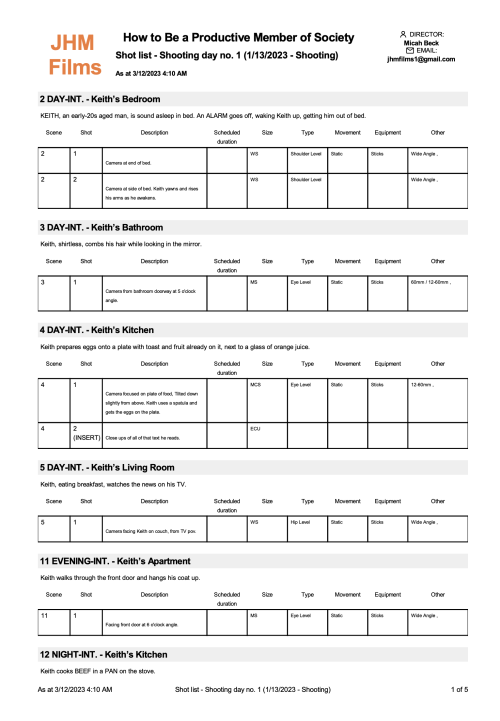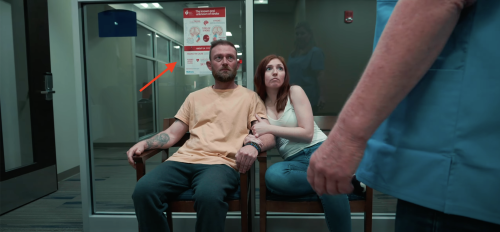At the beginning of this year, I wrote and directed a short film for my Production I class at Kent State University. This is Part Two of a four-part blog series dives in-depth into the process of creating How to Be a Productive Member of Society, my first [proper] short film… because this was the first film I produced and directed that had a complete and proper film set, planning process, production process.
<– Click here to read Part One // Click here to read Part Three (when it’s available) –>
Preproduction and planning
This was by far the most challenging part of the process. One of the things our professor made very clear was the difficulty in gaining the 11 locations we would require for our different shots. This was certainly the worst part of preproduction, as this involved making many phone calls, leaving voicemails, lots of emailing back and forth… and lots of no’s. Our college has a handbook for films produced within our major, and one of the requirements is that every location signs a contract allowing the usage. Fair enough, but this was hard, especially as college students with an extremely limited budget for this film.


One of the hardest locations was randomly Keith’s apartment location, which was actually my girlfriend Bella’s apartment. You see, we had to have permission from either the owner of the property or management on behalf of the owner. Her giant apartment complex was not too keen on the idea of college students filming inside a paying tenant’s apartment, even with the tenant’s approval, with their reasoning being due to construction in the building. It took a lot of persuasion and phone calls talking to different people at many management levels within the apartment complex to finally get the signature we needed (on the condition that our work was fully contained within that apartment, and not in any hallways or common areas, which we hadn’t planned on anyway). We came close to getting screwed there.

The rest of the locations weren’t as hard, but we did have to cut a few scenes due to not having any locations; the most significant being a church wedding scene. Lots of our locations actually came from Kent State’s campus itself, which was a big help. It also helped to consolidate some locations and use them for multiple purposes.. as well as using multiple nearby locations in one shoot day. For example, the reception area of the office where we filmed the office scenes was used as the doctor’s waiting room, and one of the empty offices was the examination room. And the restaurant (a campus dining hall) and gym (a fitness room in one of the residence halls) were right next door.
We also had to cast at this point as well. Luckily, as students, we get a free subscription to Backstage.com, a website for actors and creatives posting and responding to casting calls. We also reached out to our campus theatre program, but due to the slightly older roles, we found all of our talent but one (story on that later) from Backstage. We held virtual auditions and found some great local actors: Matt, Katie, and Brad.
We then had to figure out scheduling, costumes, and crew. Luckily, I was able to focus on more of the creative side of things while the producers handled lots of the logistical things. Spreadsheets were a godsend throughout this process, as was a production management tool we found called Yamdu.
This website allowed us to import our script and automatically detect every location, prop, costume, among more. With this tool, we were able to generate lists for all of those as well as what their associated real-world counterpart would be (i.e. the “gym” would be the Kent State Rotunda Rec Room), plus our shot lists/storyboards, budget breakdowns, beat boards, and call sheets. This made things so much easier and saved us many hours, as instead of highlighting the script by hand for each thing we would need to plan, we could do it digitally and link it to its respective category and asset. We could even upload our receipts from purchases we made to keep a running total of our expenditures and try to stay within budget. Yamdu cost $9/month, but it was worth every penny, which ended up being only $27 anyway.

We had to also purchase and create some of our props. We tried not to overspend in this category, instead relying on mostly items we already individually possessed to serve as props and set decoration. Still, there were a few things that required some extra care. This involved printing medical posters to make our “doctor’s office” feel legit, and printing fake bills and mail for Keith to open; we also had to purchase the food that Keith prepares (well, technically it was prepared by our food stylist, Lochlan).


We also had to reserve equipment through our college’s Student Resource Lab, a resource for tools and equipment for video and film shoots. This involved many, many lights, C-stands, cameras, rigs, diffusers, microphones, tripods, audio recorders, and more. This was a difficult process, as they only had a limited number of equipment, and so there was never guaranteed availability, with many other students working on their films at the same time.
We then held our table reading. This was the first interaction our cast members had, and we got to explain some things about the film as well as rehearse some elements. Now, as I mentioned, this film isn’t heavy with character dialogue, instead it’s mostly intrapersonal. However, it was a good chance to hear the script read out loud and to feel the emotions of it all — the first thing Matt (who played Keith) said after we finished the table read was “Wow. That’s real.”
We also got to rehearse the kissing scenes we had, which was important to practice and set boundaries with things. Our intimacy coordinator, Noah Brock, came from the theatre program at Kent State, and WOW, did they know what they were doing! They worked with Matt and Katie, our leads, for close to an hour to turn the kissing scenes into a sort of “rhythm”, almost as if it were a dance being choreographed. It was very interesting to watch and made our actors the most comfortable.
